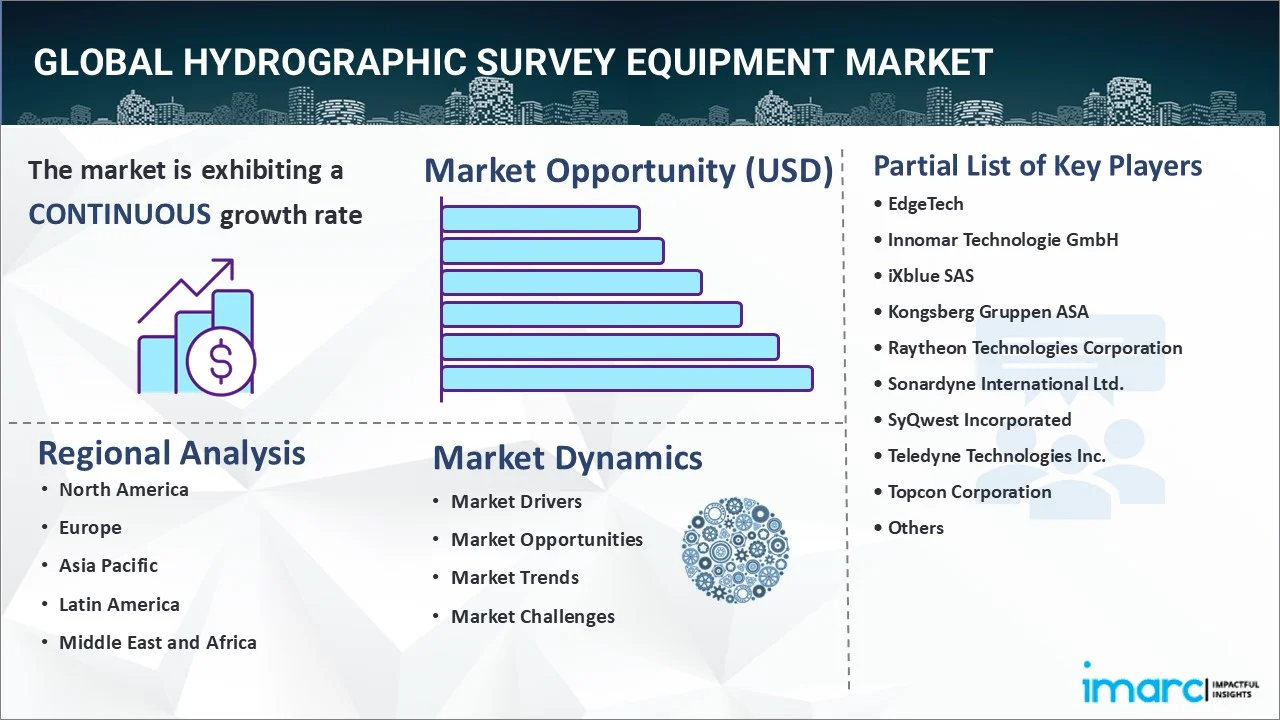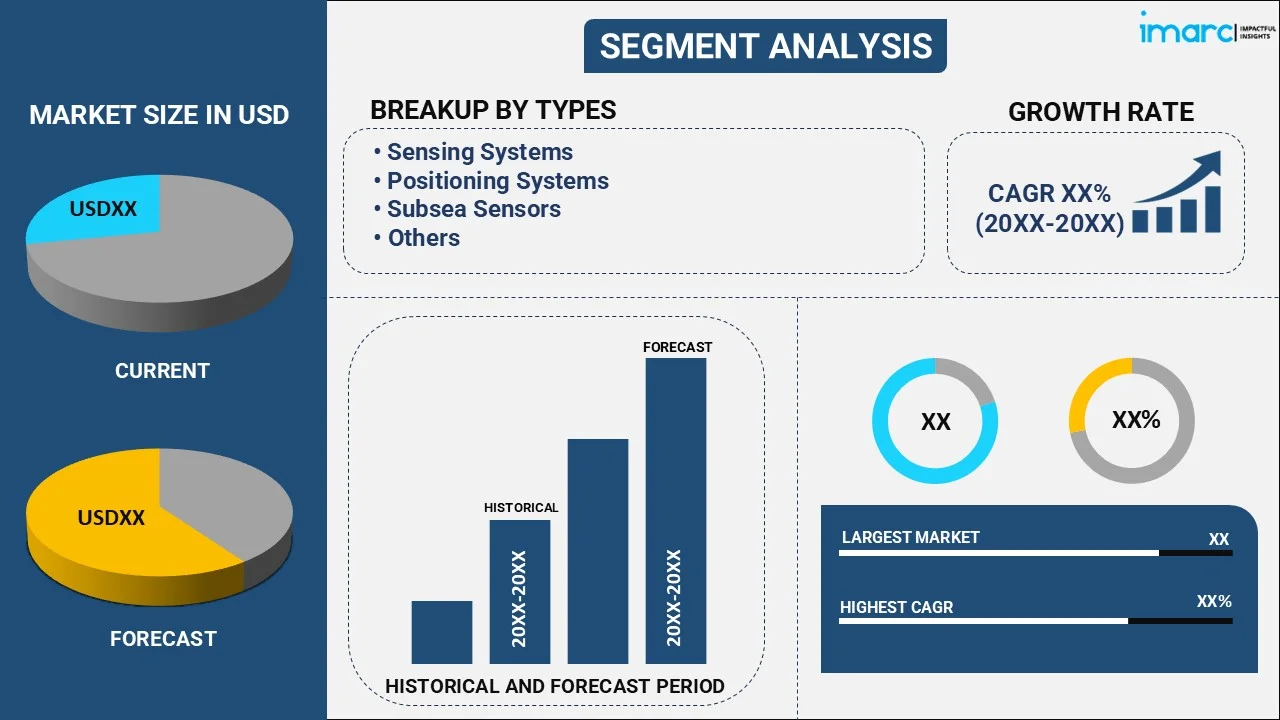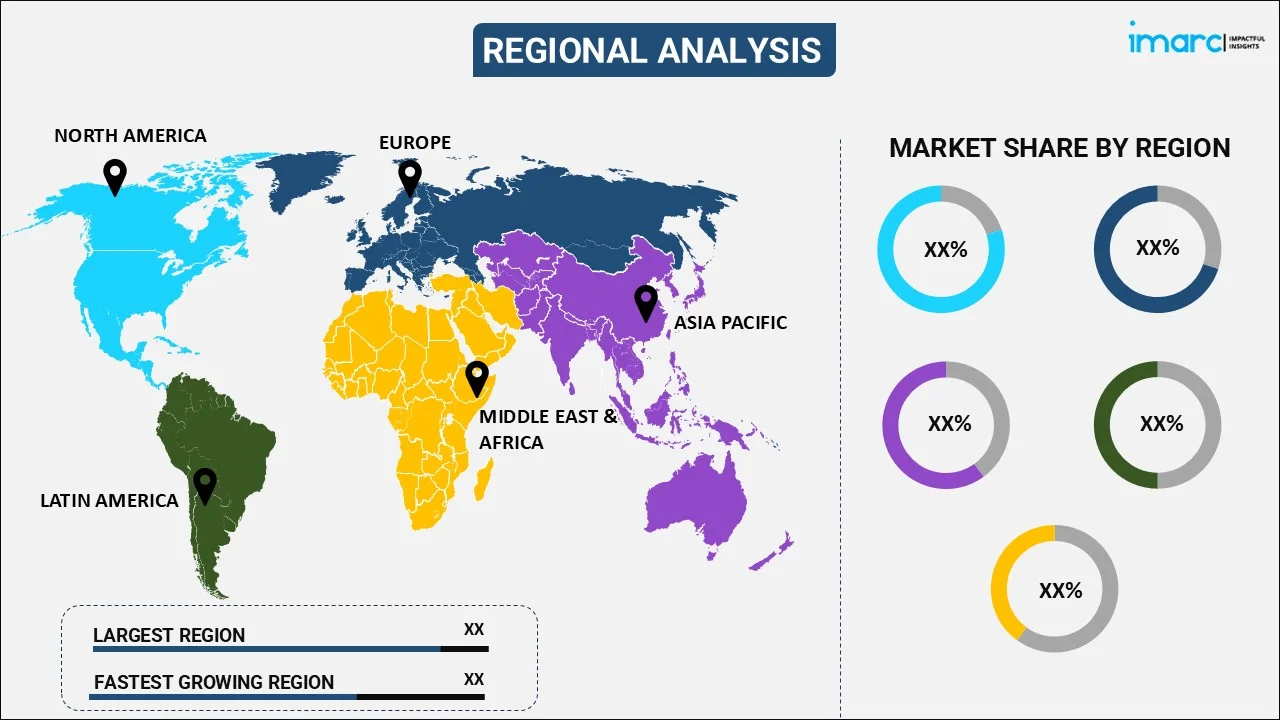
Hydrographic Survey Equipment Market Report by Type (Sensing Systems, Positioning Systems, Subsea Sensors, Software, Unmanned Vehicles, and Others), Depth (Shallow Water, Deep Water), Platform (Surface Vessels, USVs and UUVs, Aircraft), Application (Hydrographic or Bathymetry Survey, Port and Harbor Management, Offshore Oil and Gas Survey, Cable or Pipeline Route Survey, and Others), End Use (Commercial, Research, Defense), and Region 2025-2033
Hydrographic Survey Equipment Market Overview:
The global hydrographic survey equipment market size reached USD 3.3 Billion in 2024. Looking forward, IMARC Group expects the market to reach USD 4.9 Billion by 2033, exhibiting a growth rate (CAGR) of 4.7% during 2025-2033. Increasing need for accurate and up-to-date marine charts and maps, the growing emphasis on offshore exploration and production activities, and rising investments in infrastructure development represent some of the key factors driving the market.
|
Report Attribute
|
Key Statistics
|
|---|---|
|
Base Year
|
2024 |
|
Forecast Years
|
2025-2033
|
|
Historical Years
|
2019-2024
|
|
Market Size in 2024
|
USD 3.3 Billion |
|
Market Forecast in 2033
|
USD 4.9 Billion |
| Market Growth Rate (2025-2033) | 4.7% |
Hydrographic survey equipment is used for mapping and measuring the physical features of water bodies, such as oceans, rivers, and lakes. It is essential for various industries, including offshore oil and gas exploration, navigation, and environmental monitoring. The equipment typically includes sonar, global positioning systems (GPS), and other sensors that allow for accurate measurements of the water depth, current speed, and underwater features. The hydrographic survey equipment comprises a survey vessel, echo sounder, sonar system, GPS, and a data acquisition system as standard components. The survey vessel is equipped with the latest technology to ensure the accuracy of the equipment. The echo sounder emits a sound pulse that bounces off the seabed and returns to the sensor. The time it takes for the sound to travel is used to calculate the depth of the water. The advantages of hydrographic survey equipment are numerous, such as providing detailed information about the water depth, underwater features, and currents which is essential for safe navigation. It also helps identify and mitigate potential hazards to offshore infrastructure, such as oil rigs and pipelines. In addition to this, hydrographic survey equipment plays a critical role in environmental monitoring by providing data on water quality and the health of aquatic ecosystems. In comparison to other survey methods, hydrographic survey equipment offers more detailed and accurate data. It also enables surveyors to work in real-time and quickly identify potential hazards or issues. Currently, there are different types of product variants in the market, including single-beam echo sounders, multibeam echo sounders, side-scan sonar, and sub-bottom profilers.

Hydrographic Survey Equipment Market Trends:
The global hydrographic survey equipment market is primarily driven by the increasing need for accurate and up-to-date marine charts and maps and the growing emphasis on offshore exploration and production activities, such as oil and gas exploration. This is further bolstered by rising investments in infrastructure development, coastal zone management, and environmental monitoring projects, particularly in emerging economies. Moreover, favorable technological advancements in surveying equipment, including the development of multibeam sonar systems, light detection and ranging (LiDAR), and autonomous underwater vehicles (AUVs), and stringent government regulations and guidelines pertaining to maritime safety and environmental protection are creating a positive outlook for the market. The expansion of the maritime tourism industry and the growing need for accurate seabed mapping for recreational activities are acting as other factors contributing to the market growth. Apart from this, the shifting focus on underwater archaeology and the rising incidents of natural disasters are creating a positive outlook for the market. Furthermore, the expansion of the fishing industry and the escalating need for accurate mapping of fish habitats and oceanographic features are fueling the market growth. Other factors, such as the surging awareness and concern about marine pollution and the growing adoption of unmanned systems, including autonomous surface vessels (ASVs) and remotely operated vehicles (ROVs), for hydrographic surveys are propelling the market growth.
Key Market Segmentation:
IMARC Group provides an analysis of the key trends in each sub-segment of the global hydrographic survey equipment market report, along with forecasts at the global, regional and country level from 2025-2033. Our report has categorized the market based on type, depth, platform, application, and end use.
Type Insights:

- Sensing Systems
- Positioning Systems
- Subsea Sensors
- Software
- Unmanned Vehicles
- Others
The report has provided a detailed breakup and analysis of the hydrographic survey equipment market based on the type. This includes sensing systems, positioning systems, subsea sensors, software, unmanned vehicles, and others. According to the report, unmanned vehicles accounted for the largest market share.
Depth Insights:
- Shallow Water
- Deep Water
The report has provided a detailed breakup and analysis of the hydrographic survey equipment market based on the depth. This includes shallow water and deep water. According to the report, shallow water accounted for the largest market share.
Platform Insights:
- Surface Vessels
- USVs and UUVs
- Aircraft
The report has provided a detailed breakup and analysis of the hydrographic survey equipment market based on the platform. This includes surface vessels, USVs and UUVs, and aircraft. According to the report, USVs and UUVs accounted for the largest market share.
Application Insights:
- Hydrographic or Bathymetry Survey
- Port and Harbor Management
- Offshore Oil and Gas Survey
- Cable or Pipeline Route Survey
- Others
The report has provided a detailed breakup and analysis of the hydrographic survey equipment market based on the application. This includes hydrographic or bathymetry survey, port and harbor management, offshore oil and gas survey, cable or pipeline route survey, and others. According to the report, offshore oil and gas survey accounted for the largest market share.
End Use Insights:
- Commercial
- Research
- Defense
The report has provided a detailed breakup and analysis of the hydrographic survey equipment market based on the end use. This includes commercial, research, and defense. According to the report, commercial accounted for the largest market share.
Regional Insights:

- North America
- United States
- Canada
- Asia-Pacific
- China
- Japan
- India
- South Korea
- Australia
- Indonesia
- Others
- Europe
- Germany
- France
- United Kingdom
- Italy
- Spain
- Russia
- Others
- Latin America
- Brazil
- Mexico
- Others
- Middle East and Africa
The report has also provided a comprehensive analysis of all the major regional markets, which include North America (the United States and Canada); Europe (Germany, France, the United Kingdom, Italy, Spain, Russia, and others); Asia Pacific (China, Japan, India, South Korea, Australia, Indonesia, and others); Latin America (Brazil, Mexico, and others); and the Middle East and Africa. According to the report, North America was the largest market for hydrographic survey equipment. Some of the factors driving the North America hydrographic survey equipment market included the robust expansion of the maritime industry, the stringent regulations and guidelines imposed by regulatory bodies, and continuous advancements in technology, including the development of innovative sonar systems, LiDAR, and unmanned systems.
Competitive Landscape:
The report has also provided a comprehensive analysis of the competitive landscape in the global hydrographic survey equipment market. Competitive analysis such as market structure, market share by key players, player positioning, top winning strategies, competitive dashboard, and company evaluation quadrant has been covered in the report. Also, detailed profiles of all major companies have been provided. Some of the companies covered include EdgeTech, Innomar Technologie GmbH, iXblue SAS, Kongsberg Gruppen ASA, Raytheon Technologies Corporation, Sonardyne International Ltd., SyQwest Incorporated, Teledyne Technologies Inc., Topcon Corporation, Tritech International Limited (Moog Inc.), Valeport Ltd., etc. Kindly note that this only represents a partial list of companies, and the complete list has been provided in the report.
Report Coverage:
| Report Features | Details |
|---|---|
| Base Year of the Analysis | 2024 |
| Historical Period | 2019-2024 |
| Forecast Period | 2025-2033 |
| Units | Billion USD |
| Segment Coverage | Type, Depth, Platform, Application, End Use, Region |
| Regions Covered | Asia Pacific, Europe, North America, Latin America, Middle East and Africa |
| Countries Covered | United States, Canada, Germany, France, United Kingdom, Italy, Spain, Russia, China, Japan, India, South Korea, Australia, Indonesia, Brazil, Mexico |
| Companies Covered | EdgeTech, Innomar Technologie GmbH, iXblue SAS, Kongsberg Gruppen ASA, Raytheon Technologies Corporation, Sonardyne International Ltd., SyQwest Incorporated, Teledyne Technologies Inc., Topcon Corporation, Tritech International Limited (Moog Inc.), Valeport Ltd., etc. |
| Customization Scope | 10% Free Customization |
| Post-Sale Analyst Support | 10-12 Weeks |
| Delivery Format | PDF and Excel through Email (We can also provide the editable version of the report in PPT/Word format on special request) |
Key Benefits for Stakeholders:
- IMARC’s report offers a comprehensive quantitative analysis of various market segments, historical and current market trends, market forecasts, and dynamics of the hydrographic survey equipment market from 2019-2033.
- The research study provides the latest information on the market drivers, challenges, and opportunities in the global hydrographic survey equipment market.
- The study maps the leading, as well as the fastest-growing, regional markets. It further enables stakeholders to identify the key country-level markets within each region.
- Porter's five forces analysis assist stakeholders in assessing the impact of new entrants, competitive rivalry, supplier power, buyer power, and the threat of substitution. It helps stakeholders to analyze the level of competition within the hydrographic survey equipment industry and its attractiveness.
- Competitive landscape allows stakeholders to understand their competitive environment and provides an insight into the current positions of key players in the market.
Key Questions Answered in This Report
The global hydrographic survey equipment market was valued at USD 3.3 Billion in 2024.
We expect the global hydrographic survey equipment market to exhibit a CAGR of 4.7% during 2025-2033.
The rising number of maritime trade activities, along with the increasing adoption of hydrographic survey equipment as it aids in producing detailed plans of harbors, seabeds, and waterways showcasing shapes, depths, and contours, is primarily driving the global hydrographic survey equipment market.
The sudden outbreak of the COVID-19 pandemic had led to the implementation of stringent lockdown regulations across several nations, resulting in the temporary closure of numerous ports, thereby negatively impacting the global market for hydrographic survey equipment.
Based on the type, the global hydrographic survey equipment market can be segmented into sensing systems, positioning systems, subsea sensors, software, unmanned vehicles, and others. Currently, unmanned vehicles hold the majority of the total market share.
Based on the depth, the global hydrographic survey equipment market has been divided into shallow water and deep water, where shallow water currently exhibits a clear dominance in the market.
Based on the platform, the global hydrographic survey equipment market can be categorized into surface vessels, USVs and UUVs, and aircraft. Currently, USVs and UUVs account for the majority of the global market share.
Based on the application, the global hydrographic survey equipment market has been segregated into hydrographic or bathymetry survey, port and harbor management, offshore oil and gas survey, cable or pipeline route survey, and others. Among these, offshore oil and gas survey currently holds the largest market share.
Based on the end use, the global hydrographic survey equipment market can be bifurcated into commercial, research, and defense. Currently, commercial exhibits a clear dominance in the market.
On a regional level, the market has been classified into North America, Asia-Pacific, Europe, Latin America, and Middle East and Africa, where North America currently dominates the global market.
Some of the major players in the global hydrographic survey equipment market include EdgeTech, Innomar Technologie GmbH, iXblue SAS, Kongsberg Gruppen ASA, Raytheon Technologies Corporation, Sonardyne International Ltd., SyQwest Incorporated, Teledyne Technologies Inc., Topcon Corporation, Tritech International Limited (Moog Inc.), and Valeport Ltd.
Need more help?
- Speak to our experienced analysts for insights on the current market scenarios.
- Include additional segments and countries to customize the report as per your requirement.
- Gain an unparalleled competitive advantage in your domain by understanding how to utilize the report and positively impacting your operations and revenue.
- For further assistance, please connect with our analysts.

 Inquire Before Buying
Inquire Before Buying
 Speak to an Analyst
Speak to an Analyst
 Request Brochure
Request Brochure
 Request Customization
Request Customization



.webp)




.webp)












